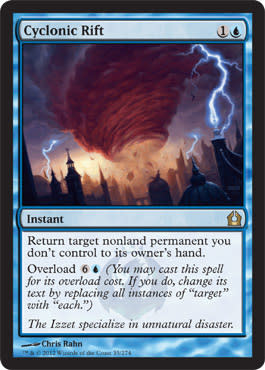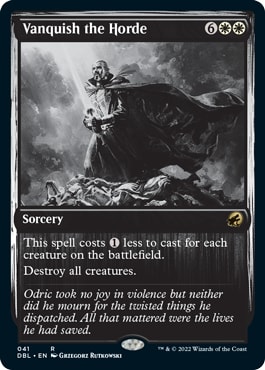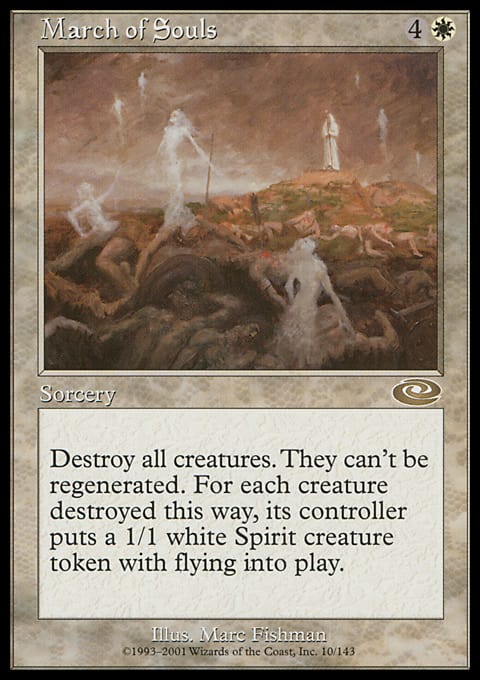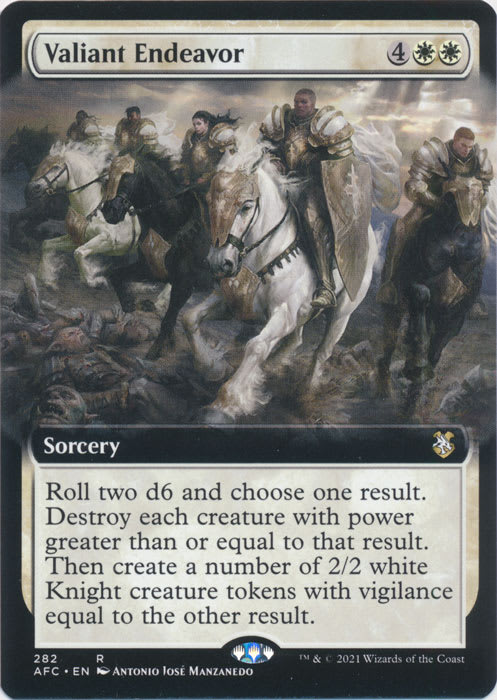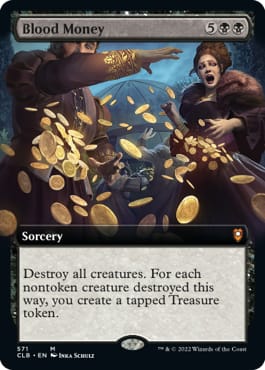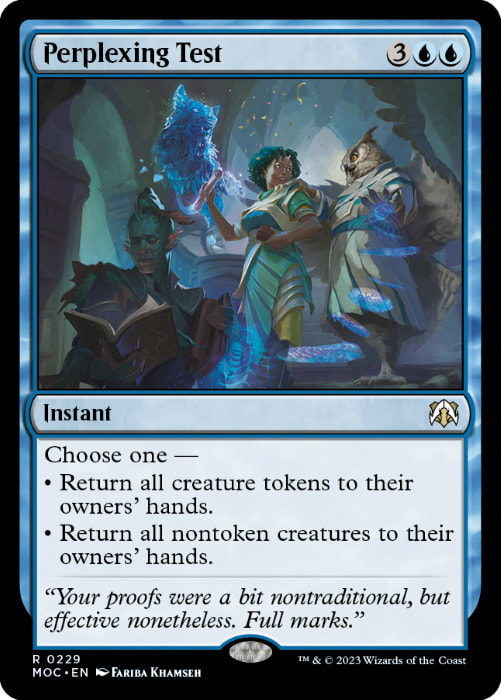Last time, we explored some of the more underrated spot-removal spells in Commander:
Hyping Up Some Underrated Removal Spells in Commander
In today's thrilling continuation, we'll venture past the single-shot weaponry and dive right into heavy munitions: Mass Removal. The 4-player nature of the Commander sees boards fill up quickly and with all manner of destructive machinery, so packing at least a 2-3 'Wrath effects is highly recommended for any deck. Regardless of strategy. The tricky part is knowing when to deploy these sweepers. Spot removal is often more direct in nature. If dragon is trying to eat your skull, it's probably best to use that Chaos Warp right away. With mass removal, immediacy can make for easy decisions, but more often than not, you'll find yourself asking "when's the best time to hit the reset button?". Do you let your opponents play out more threats, risking damage along the way for the chance to destroy extra cards? Is the current board state too dangerous to let survive, or is that same danger being pointed in other directions, letting your opponents hurt each other without you lifting a finger? And if you do decide to press the shiny red button, how quickly will you be able to rebuild versus your opponents?
With mass removal being such a pivotal tool, reprints of popular staples are necessary to keep prices down. Blasphemous Act is a near auto-include in Red decks, yet remains inexpensive because it's appeared in over ten Commander precons over the years. The Lord of the Rings: Tales of Middle Earth brought Toxic Deluge under the twenty-dollar mark, making it far more accessible for players on a budget. A myriad of card styles and the dubious existence of Double Feature has kept Vanquish the Horde under five dollars. Alas, while Cyclonic Rift's price tag remains lofty despite the occasional reprint, it's fortunately more of the exception than the rule.
But everyone knows about these spells. As well they should, as they're all excellent, efficient sweepers. However, just as a whole world of overlooked spot removal floats around the cardboard archives, so too dwells an arsenal of unexplored mass removal. These may not be as readily powerful or straightforward as my previous examples, but potential lies in the nuance. Niche applications, by their very nature, won't be as universally recognized as the tried-n-true staples. As a result, there is a variety of interesting and complex sweeper spells that have gone largely overlooked, despite many synergizing with popular Commander strategies and deck archetypes.
So, fire up that torch, because we're venturing into the darker corners of the library. Let's wipe away the dust and see what arcane artillery has been forgotten. Perhaps a destructive diamond lies in hiding? Just as we did with spot removal, we'll start by exploring what elements to look for when picking out mass removal spells.
Qualities to Look for in Commander Mass-Removal
- Mana Efficiency: Ex. Toxic Deluge, Blasphemous Act. Due to their wide-scale nature, sweepers tend to start at higher converted mana values than their single-target cousins. The classic Wrath of God is still considered to be fairly priced at four mana, and even sweepers in the 5- and 6- mana range are considered perfectly playable, albeit those pricier costs often come with bonus features. We'll get to those in a minute. Most forms of mass removal that come in under four mana are considered highly efficient, though often requires an extra form of 'payment' (Toxic Deluge, Sunscour, etc.), or a condition to be met that reduces the price tag Blasphemous Act.
- Speed: Ex. Starstorm, Rout. Often, if you're casting a sweeper, you're taking up your own turn to do so. Effects as dramatic as 'blow up the world' tend come at Sorcery speed, though Instant exceptions are out there. These most often take the form of scalable-damage like Starstorm and Magmaquake. Speedier 'Wrath-effects exist, but'll often cost more mana, as dropping something like Fated Retribution or a 'kicked' Rout at the end of your opponent's turn is a huge advantage, as you'll be the first player who gets to untap and start rebuilding from the blast.
- Versatility: Ex. Ruinous Ultimatum, Farewell. Much like targeted removal, the more types of card a sweeper can hit, the more useful it is. Most of the time, at least. For while you'll have no qualms about running a Disenchant-effect in your Enchantress deck, you might hesitate to run an Akroma's Verdict, lest your own enchantments fall prey. This is where spells that not only hit multiple card types, but also allow for flexibility, can really come in handy. Farewell, Austere Command, and Merciless Eviction have seen tons of play for this very reason. You get to pick the best option to aim the crosshairs at. Alternatively, you could invest a ton of mana to purge just your opponents' resources, such as via Ruinous Ultimatum or In Garruk's Wake. The finality component is also important to consider, as Exile- (Ex. Sunfall), Tuck- (Hallowed Burial), and Sacrifice- (Ex. All is Dust, By Invitation Only) effects get around pesky Indestructible or Regeneration abilities.
- Restrictions: Ex. The Battle of Baywater, Hour of Devastation. Another way to tailor a sweeper spell to a given strategy is to use cards that outright ignore your own game plan. If you're going wide with an army of tokens, something like The Battle of Baywater or Retribution of the Meek could leave your team unscathed while eliminating larger threats. A ramp deck full of gigantic creatures easily shrugs off Hour of Devastation or Yahenni's Expertise. Wave of Reckoning is everything an Arcades, the Strategist deck full of Walls could ever ask for. Each of these spells offers you the chance to remove enemy resources without impacting your own, with the drawback being you won't remove enemy cards that meet the same criteria. The Battle of Baywater will leave your legion of small creatures alone, but it'll also ignore any smaller creatures opponents control. This drawback segues nicely into...
- Drawback: Ex. Living Death. Much like how the aforementioned restrictions can miss certain threats, other forms of mass removal come with drawbacks that need to be carefully considered before you using them. Living Death can stir a massive swing in resources, but if you play it after tons of creatures have already died, it'll carry a whole boatload of enemy critters back from the grave, too. Bounce-based sweepers like Inundate and Engulf the Shore put your opponents behind, but don't answer their creatures for good. The line between what constitutes Restriction versus Drawback often comes down to context, especially in a format as complex as Commander. At the end of the day, you're the one casting the spell, so use your best judgment as to what the most opportune moment is. One that note...
- X-for-1 Potential: This is an easy one, as nearly all mass-removal spells offer the potential for card advantage, especially in a 4-player format. That said, don't fall victim to the trap of letting a 'wrath sit in your hand forever. There's a temptation to hang onto that sweeper spell and watch opponents play out more threats, but if you wait too long, those threats can overwhelm or surprise you. Don't hesitate to cast Wrath of God with a single creature on board if that lone threat is enough to kill you. It's not the most efficient use of spell, but what's the point of efficiency if you're dead?
- Bonus Effects: Ex. Necromantic Selection, Supreme Verdict. Some of my favorite mass removal effects are those that leave a gift behind. Cards like Necromantic Selection and Phyrexian Rebirth clear away threats, then start rebuilding right away with a replacement creature. Add another color, and suddenly Wrath of God morphs into the counter-proof Supreme Verdict. If the bonus effect is powerful enough, it's essentially free card advantage. In some cases, it's literal card advantage (Decree of Pain). No matter the format, card advantage is king, making sweepers with bonus effects some of the most alluring options out there.
Now let's take these principles and apply them to a group of underrated mass removal spells. We'll analyze each under the lens of destructive potency, utility, and applications that may not be apparent on the surface. I feel each of these cards warrants more exploration, and much like the overlooked removal we discussed in our prior article, each comes with the added benefit of being easy on the wallet.
Let's dive right in!
March of Souls
So, what if Afterlife, but for everyone?
That's the question March of Souls poses. Once the dust settles, all players will have the same number of creatures they did before the blast wave, only they'll be spectral wisps of their former selves. It'll flavorfully obliterate a problematic board without restriction, but unlike something like Martial Coup or Phyrexian Rebirth, you're not the only one who receives the bonus. All players get a spirit token in return for each creature slain. So why bother with such a drawback when something like Sunfall exists? It's all about your strategy. If you're looking to go-wide or produce a legion of tokens, it's a good chance their base stats already start at 1/1. Think Mites, Soldiers, Halflings, Humans, or funnily enough, Spirit tokens. In these decks, March of Souls makes no change to your number of creatures, or their stat line, but does grant them all evasion. At the same time, you've eliminated all the bigger threats on the other sides of the table. While your opponents' new spirit tokens are the same size as your own, odds are your army will outnumber theirs. Plus, the nature of your strategy makes it likely your spirits will be bigger than everyone else's when it's time to go attacking. Anthem-effects like Honor of the Pure or the new Flowering of the White Tree are already mainstays in decks that make a lot of creatures, as are mass ability-granting cards like True Conviction and Akroma's Will. And if you really want to get mean, combine March of Souls with Cathars' Crusade to ensure your fresh batch of spirits are far, far larger than any your opponents receive.
Wave of Vitriol
It's easy to overlook Wave of Vitriol when Bane of Progress whispers sweet temptations of +1/+1 counters into your ears. Both cards benefit from copious ramp, something Green hardly needs any help with via the very mana rocks these cards are looking to blow up. Each not only destroys dangerous artifacts and enchantments, but also wipes out the rock-based ramp other colors rely on. Bane of Progress comes with a bonus elemental to dole out damage, but Wave of Vitriole can actually be more detrimental to your opponents' health in the long run. The card has greatly improved over the last few years due to the simple fact that mana bases are far greedier now than they used to be. With so many color-fixing nonbasics, any deck that's three or more colors might find itself unable to tutor up basic lands equivalent to the nonbasics Wave of Vitriol destroys, leaving them down on land count. Between fetches, shocks, triome, filter, battle, fast, slow, canopy, and a whole bunch of other nonbasic cycles, space for simple basics has grown tighter. Heck, the increasing number of nonbasics with two land or more types (think Hallowed Fountain, Jetmir's Garden, etc.) has even made other Green-multicolored decks that'd typically rely on land searching via Farseek and whatnot more vulnerable to this effect. And if decks instead ramp via mana rocks, no problem. You've also blown those up, too! Meanwhile, your optimal deck is likely one or two colors and creature-centric, thus largely unaffected. By wrecking artifact, enchantment, and multicolored strategies, Wave of Vitriol hits multiple popular deck types in one devastating tsunami.
Necrotic Hex and Valiant Endeavor
These pair nicely, as they both promise a similar effect: Wipe out a bunch of creatures, then make an army for yourself. Each provides tokens of highly-relevant, well-supported creature types. Of the two, Necrotic Hex is the more reliable, as you're guaranteed six sacrifice triggers per player and twelve power right off the bat. Forcing opponents to sacrifice creatures gets around protective abilities, and nixing six creatures on each side of the table is a big number. All in all, you're getting a lot of value. The one shortcoming, like many cards that force opponents to sacrifice creatures, is in how they get to make the choice what to sacrifice. As mentioned, six creatures is a lot, so Necrotic Hex will often wipe entire boards, but token-heavy or creature-centric builds could get around this via sheer numbers. In these cases, their best creature(s) will survive and likely be headed your way. Remember, your new undead fleet is unable to block at first. Valiant Endeavor's chance-factor makes it harder to pin down, especially considering White doesn't have many dice-rolling synergies. Rolling two dice certainly helps, as you'll always be able to pick the lower number for the 'wrath-effect and the higher one for the knights. Getting snake-eyes isn't stellar, essentially providing a small Phyrexian Rebirth, but is still serviceable and completely wipes the board. Double sixes will kill the fewest creatures, but it'll still eliminate large Voltron-style commanders and provide you the biggest army. Your best combo is one high, one low, for maximum numbers of creatures destroyed and the max number of knights. This might seem like too many hoops to jump through, but consider this: Your ability to choose 1 of 2 numbers essentially makes this sweeper tailored to creature power. The knight tokens are more of a bonus, but the real power is in your ability to sweep the board at a stat level that potentially leaves your team untouched. If you're running tokens, odds are your team is on the smaller side stats-wise, so Valiant Endeavor provides the possibility to sweep the board of larger threats while leaving your team untouched, then providing even more tokens as a bonus effect.
Nightmare Unmaking
Five mana, finality via Exiling, and a modal-feature that lets you choose which creatures fall victim: that's a winning combination that makes Nightmare Unmaking worthy of far more play than it currently receives. Like the aforementioned Valiant Endeavor, this sweeper provides the chance to spare some or even all of your army, depending on your choice. However, unlike Valiant Endeavor, there's no worry about a chance-factor. You can simply count the cards in hand and make the call from there. This can tackle both the go-tall and the go-wide. If you're near or at Hellbent, Nightmare Unmaking acts as a solid 'wrath effect that exiles. If you're hand is stacked, you have the option to nuke everything smaller or take out one massive threat. The only pinch point is somewhere in the middle, where you might not hit everything standing against you, but at the same time, you've the option of leaving a portion of your own team intact. That modal factor is key to this card's effectiveness, as it can be more versatile than a standard sweeper, but does require you to monitor cards in hand versus what you'd like exiled. Not a difficult hoop to jump through, but one to bear in mind.
Fell the Mighty
It's easy to look at Fell the Mighty as a second copy of Wave of Reckoning. For the decks that want Wave of Reckoning, that's perfectly fine. But there's an easily-missed caveat that sets Fell the Mighty apart: It can target any creature. This means that, while you'll need a viable target to eliminate everything with greater power, you'll have multiple players worth of options to choose from. It's a useful feature that prevents the spell from otherwise being dead when you've no creatures in play, yourself. That said, it'll most often be your own creature targeted with this spell, as you can't control what critters your opponents play, but you can play out your own in such a way to get the biggest benefit. Go-wide decks will use it as a Retribution of the Meek-style effect, but even if you're playing bigger creatures, Fell the Mighty can always target something medium-to-large to eliminate even more massive threats on the other side of the table. Being a Destroy-effect, it won't get around protective abilities like Indestructible, but very few other sweepers designed to slay larger creatures give you the chance to keep your 5- or 6- power creatures, too. Just make sure you play those creatures first.
Blood Money
While our last three entries required some degree of setup, Blood Money does away with that and simply asks "How much Treasure do you want?". Yes, it comes in at a hefty seven mana, and those tokens can't be cashed in immediately, but to clear the board of all creatures and receive payment for their demise can be crushingly powerful. Some of Black's best finishers are mana-sinks like Exsanguinate and Torment of Hailfire, both of which are perfect follow-up plays once the pile of riches lands in your lap. Combine this with a Pitiless Plunderer for even more loot. Even decks with no other treasure-synergy will find themselves stealing wins when they combine this card with Revel in Riches. Yes, Blood Money demands a high casting cost, but don't worry, it often gives your investment right back to. With interest.
Immolating Gyre
While Spell-Slinger decks require nuance to construct, ensuring you've the proper blend of removal, card advantage, and combo/win pieces, Immolating Gyre is refreshing direct in its application within said decks. If your commander cares about copious Instants/Sorceries (Ex. Mizzix of the Izmagnus, the new Gandalf the Grey or Saruman, the White Hand, Niv-Mizzet, Parun and his counterparts, etc.) or Burn spells (Solphim, Mayhem Dominus, Urabrask // The Great Work, Aegar, the Freezing Flame, etc.), odds are Immolating Gyre will have plenty of cards to count by the time you hit six-mana. Yes, you'll need to keep a well stocked graveyard to stoke the biggest fire, but the heat will always be against opposing creatures and planewalkers. Never your own. Immolating Gyre requires build up, but it'll never sets you back on board, allowing your Guttersnipe and Archmage Emeritus to keep right on triggering off subsequent spells.
Perplexing Test
An Evacuation with a twist, Perplexing Test offers the same Instant speed and mana value with a bit of extra fine print when it comes to tokens. On one hand, you can bounce all non-token creatures, which works great with token-centric Commanders like Adrix and Nev, Twincasters, Brudiclad, Telchor Engineer, and Alandra, Sky Dreamer, but it'll leave behind enemy tokens, too. Or, you can turn Perplexing Test into a token-specific 'wrath effect that'll permanently destroy all opposing creature tokens without touching anything else. What matters is how you're able to select the option that best suites the board state, so even if you don't whisk away everything, you'll still hit the most threatening card(s). If you're looking for another mass-bounce effect, considering giving Perplexing Test a try for its selective options.
Decree of Annihilation
We end today's adventure with a look at Decree of Annihilation, though many of Red's older sweepers that destroy cards rather than deal damage also apply. Decree of Annihilation, Obliterate, Jokulhaups, and other such board wipes are all designed to bring the game back to square one, as they wipe out lands alongside artifacts and creatures. Land destruction is often frowned upon in Commander, as it can slow things down, but what if you were able to win right after the dust settled? Red's old sweepers overlook two key card types. For once, they don't hit enchantments, though outside of Ghen, Arcanum Weaver, Red isn't exactly known for its Enchantress decks. Second, and far more importantly, is the card type that didn't even exist when these cards were printed: Planeswalkers. The Superfriends strategy can make utterly game-breaking use of these effects, as not only do they miss Planeswalkers, but also kill all creatures that would threaten their loyalty count, and blow up the lands your opponents desperately need to rebuild. The fact that your own lands are also destroyed is of little consequence when your Planeswalkers are left alive to generate value and inch closer to their ulimate abilities, most of which are enough to finish everything up. If your Planeswalker deck uses Red mana, Decree of Annihilation and its brethren are more than just sweepers. They're game winners.
I hope today's exploration into the world of overlooked 'wrath effects gives you a greater appreciation for the scope of sweepers out there. No matter your strategy, there is likely a mass removal spell that'll fit your deck. And seeing as how important a tool mass removal is within Commander, knowing that there are options out there that might specifically synergize with your strategy is an exciting prospect. I encourage you to keep digging through older sets and see what other unique options are out there.
Thanks for reading, and may your armies remain intact once the dust settles.
-Matt-
















